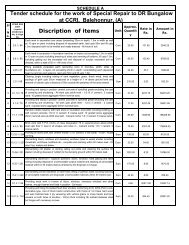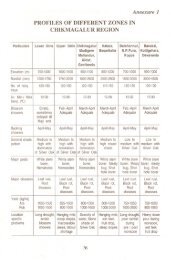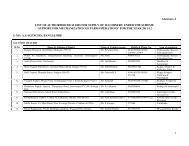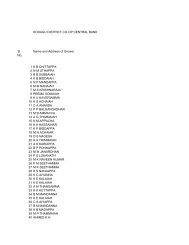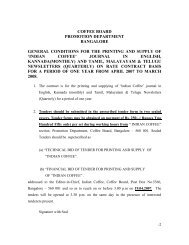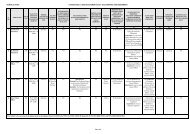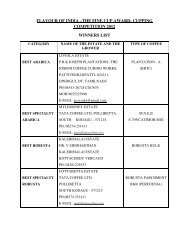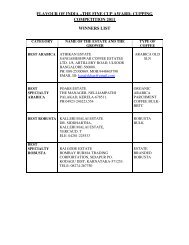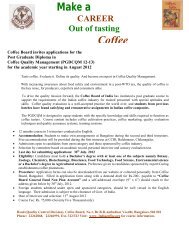COFFEE CULTIVATION GUIDE - Coffee Board of India
COFFEE CULTIVATION GUIDE - Coffee Board of India
COFFEE CULTIVATION GUIDE - Coffee Board of India
Create successful ePaper yourself
Turn your PDF publications into a flip-book with our unique Google optimized e-Paper software.
2. Pitting<br />
20<br />
Pits for c<strong>of</strong>fee planting are to be opened after few summer showers during<br />
March month. If, summer showers are delayed, this work can be deferred till the<br />
showers are received. The pits measuring 1.5 X 1.5 X 1.5 feet length, breadth and<br />
depth are ideal for planting. After opening, pits are to be exposed for weathering for<br />
15 – 20 days. Later, add 1.0 – 1.5 kgs <strong>of</strong> compost/farm yard manure and 50-100 gms<br />
<strong>of</strong> rock phosphate in each pit and close the pits by filling in with the surrounding top<br />
soil. A small bamboo stick or wooden pole can be inserted at the centre <strong>of</strong> the pit for<br />
identification.<br />
3. White Stem Borer Management<br />
All the control measures adopted during the month <strong>of</strong> February-March months<br />
should be continued. Generally the incidence <strong>of</strong> white stem borer will be on the<br />
higher side wherever the shade is less and also wherever silver oak shade trees are<br />
more. In order to minimize the incidence <strong>of</strong> WSB, optimum shade has to be<br />
maintained/ created; this will help in the healthy growth <strong>of</strong> the plants also. There is a<br />
practice <strong>of</strong> shade regulation during the month <strong>of</strong> April in some c<strong>of</strong>fee areas. If<br />
adequate blossom and backing showers are not received in time and even during<br />
April, then shade regulation work has to be postponed till sufficient moisture builds<br />
up in the soil. This will help in maintaining cool atmosphere in the c<strong>of</strong>fee estates and<br />
brings down the activities <strong>of</strong> WSB. Borer infested plants have to be thoroughly traced,<br />
uprooted and burnt. The main stem and thick primaries <strong>of</strong> the plants have to be<br />
smoothened with coir gloves and smeared with 10% lime solution. Install 25<br />
pheromone traps per hectare if the incidence level is high. Remember, retention <strong>of</strong><br />
borer infested plants results in greater damage and economic loss during the coming<br />
years compared to retaining them for a meagre pr<strong>of</strong>it expected during the current year.<br />
4. Pruning<br />
When one or two summer showers are received, c<strong>of</strong>fee plants start<br />
producing new shoots. This is the right time for pruning. Pruning essentially a<br />
thinning process to direct the vigour <strong>of</strong> the plants into those parts which produce<br />
crops. Pruning is to remove the unproductive wood for encouraging the growth <strong>of</strong><br />
new branches which would become next years cropping wood. Pruning facilitates<br />
the entry <strong>of</strong> adequate sun light and air to all parts <strong>of</strong> the bushes thereby reducing<br />
the incidence <strong>of</strong> pest and diseases and helps maintaining the frame work <strong>of</strong> the<br />
plants in desired shape.<br />
In some plantations, there is a practice <strong>of</strong> pruning the c<strong>of</strong>fee plants<br />
immediately after the harvest. But pruning operation should not be started until<br />
one or two summer showers (minimum <strong>of</strong> 2 inches <strong>of</strong> rain) are received. If<br />
sufficient moisture is present in the soil after the harvest, then pruning can be done<br />
immediately. The plants generally under stress due to mechanical injuries caused<br />
during the harvest. Under this condition if pruning is done in the absence <strong>of</strong> soil<br />
moisture, the plants suffer further stress because <strong>of</strong> the pruning operation resulting<br />
in poor future development <strong>of</strong> cropping woods. However, pruning can be done<br />
immediately after the harvest whenever the plantations are situated above 3500<br />
feet as in these elevations the weather will be cool. Precaution should be taken not<br />
to prune deeply exhausted or diseased or die –back affected plants until sufficient<br />
rain is received as indicated above. It is recommended to practice only light<br />
20



